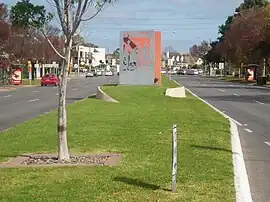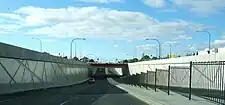Anzac Highway
Anzac Highway is an 8.7-kilometre-long (5.4 mi) main arterial road heading southwest from the city of Adelaide, the capital of South Australia, to the beachside suburb of Glenelg.[3]
Anzac Highway | |
|---|---|
 | |
| View of Anzac Highway facing southwest towards the Morphett Road intersection | |
| Coordinates |
|
| General information | |
| Type | Highway |
| Location | Adelaide |
| Length | 8.7 km (5.4 mi)[1] |
| Route number(s) | (Keswick–Glenelg) |
| Former route number | {Adelaide–Keswick) |
| Major junctions | |
| Northeast end | West Terrace Adelaide |
| Southwest end | Colley Terrace Glenelg, Adelaide |
| Location(s) | |
| Region | Eastern Adelaide, Western Adelaide, Southern Adelaide[2] |
| Major suburbs | Plympton, Camden Park |
| Highway system | |
Originally named the Bay Road (which remains an informal synonym), it mostly follows the track made by the pioneer James Chambers[4] from Holdfast Bay, the first governor's landing site, to Adelaide.[5] It gained its current name in 1923[6] to honour the contribution of the ANZACs (Australian and New Zealand Army Corps) in World War I.
Route
Commencing at the intersection with South Terrace, West Terrace and Goodwood Road on the Adelaide city centre's south-western corner, Anzac Highway heads southwest through the Adelaide Park Lands, through Plympton, before turning west through Camden Park and eventually terminating at the bayside suburb of Glenelg.
The highway is serviced by a 15-minute "Go Zone",[note 1] serviced by the 262, 263 and 265 buses.
History


The road from the city to Holdfast Bay was originally named the Bay Road.[7] After the state government was lobbied in 1917 the by the ANZAC Memorial League to rename it in honour of the ANZAC troops who fought in World War I, it eventually renamed the road to Anzac Highway in 1923, at the same time doing some roadworks. In 1937 the government, in collaboration with the West Torrens Council, Unley Council and Glenelg Council Council agreed on a plan for the future of the road, which was ratified by Parliament by the passing of the Anzac Highway Memorial Act 1937. The plan included developing a dual carriageway which included trees on the central reservation and along the verges, to be maintained by the respective councils. The trees chosen were the claret ash.[8]
On 18 September 1918, a tram line opened from Sturt Street, via West Terrace and then down the Bay Road to Keswick. It was used to transport soldiers returned from World War I to the military hospital there.[9] Known as the West City Line, ran down West Terrace and Goodwood Road turned west into Park Terrace (now Greenhill Road) before turning in to Bay Road, and terminating at the entry to the Keswick Barracks. After redevelopment of Anzac Highway in the 1930s, the tram line was eventually truncated at the new Keswick Road Bridge in March 1939, at a stop known as Wayville West. This line was closed in December 1957.[10]
The South Road intersection with Anzac Highway saw major construction works in 2007-2009 as part of a South Australian Government initiative to transform South Road into a non-stop north–south route. Under the works, both routes became grade-separated, with South Road proceeding through an underpass with bi-directional controlled exits onto Anzac Highway. The underpass model is a diamond interchange. Construction began in October 2007, and the underpass was opened in March 2009, named the Gallipoli Underpass, in keeping with the Anzac theme. Each of the four corners of the intersection has a display to commemorate those who fought in the war.
Major intersections
In popular culture
Anzac Highway is mentioned in the song "One More Boring Night in Adelaide" by Redgum on their 1978 album If You Don't Fight You Lose.
Notes
- Adelaide Metro definition: "A Go Zone is an area that offers public transport services every 15 minutes between 7.30am and 6.30pm Monday to Friday, and every 30 minutes at night, Saturday, Sunday and public holidays until approximately 10pm. Stops within Go Zones are indicated by red hoop signs."
References
- Google (29 June 2022). "Anzac Highway" (Map). Google Maps. Google. Retrieved 29 June 2022.
- "Location SA Map viewer with regional layers". Government of South Australia. Retrieved 16 June 2022.
- 2003 Adelaide Street Directory, 41st Edition. UBD (A Division of Universal Press Pty Ltd). 2003. ISBN 0-7319-1441-4.
- Kerr, Margaret Goyder Colonial dynasty: the Chambers family of South Australia Rigby Ltd., Adelaide, 1980. ISBN 0 727010972
- Perry, Dulcie M. (1985). The Place of Waters, A story of Glenelg's first fifty years. Glenelg, South Australia: The Corporation of the City of Glenelg, National Trust of South Australia. ISBN 0-9589503-0-X.
- ""Anzac Highway"". The Register. Adelaide: National Library of Australia. 11 September 1923. p. 12. Retrieved 16 January 2013.
- "Advertising". Southern Australian. Adelaide: National Library of Australia. 12 January 1841. p. 2. Retrieved 16 January 2013.
- "Claret Ash (Fraxinus oxycarpa 'Raywood')". National Trust. 24 May 2018. Retrieved 12 February 2021.
The basis for much of this information is: The West Torrens Historian Volume 7 Number 2 August 2015
- "Keswick Hospital: The Diggers Hospital". State Library of South Australia. Retrieved 12 February 2021.
- "The Western Lines". Tramway Museum, St Kilda. Retrieved 15 February 2021.
- "Location SA Map viewer with LGA layers". Government of South Australia. Retrieved 16 June 2022.
- "Location SA Map viewer with suburb layers". Government of South Australia. Retrieved 16 June 2022.
Further reading
- Manning, Geoff. "Anzac Highway: A History of the Road to Glenelg". From Place Names of South Australia (1990). State Library of South Australia.
- "Road Photos & Information: South Australia: Anzac Highway (A5)". Expressway. 15 March 2009. The opening of the "Gallipoli Underpass".
- "The fascinating history of Anzac Highway". Metro425.